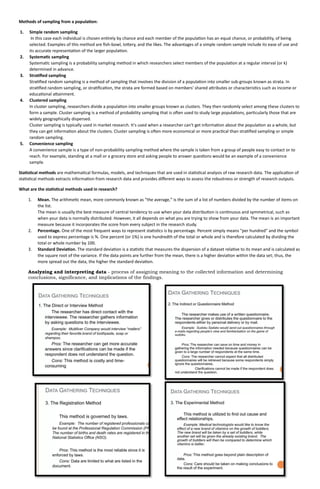
Methods of sampling from a population.pdf
- 1. Methods of sampling from a population: 1. Simple random sampling In this case each individual is chosen entirely by chance and each member of the population has an equal chance, or probability, of being selected. Examples of this method are fish-bowl, lottery, and the likes. The advantages of a simple random sample include its ease of use and its accurate representation of the larger population. 2. Systematic sampling Systematic sampling is a probability sampling method in which researchers select members of the population at a regular interval (or k) determined in advance. 3. Stratified sampling Stratified random sampling is a method of sampling that involves the division of a population into smaller sub-groups known as strata. In stratified random sampling, or stratification, the strata are formed based on members' shared attributes or characteristics such as income or educational attainment. 4. Clustered sampling In cluster sampling, researchers divide a population into smaller groups known as clusters. They then randomly select among these clusters to form a sample. Cluster sampling is a method of probability sampling that is often used to study large populations, particularly those that are widely geographically dispersed. Cluster sampling is typically used in market research. It's used when a researcher can't get information about the population as a whole, but they can get information about the clusters. Cluster sampling is often more economical or more practical than stratified sampling or simple random sampling. 5. Convenience sampling A convenience sample is a type of non-probability sampling method where the sample is taken from a group of people easy to contact or to reach. For example, standing at a mall or a grocery store and asking people to answer questions would be an example of a convenience sample. Statistical methods are mathematical formulas, models, and techniques that are used in statistical analysis of raw research data. The application of statistical methods extracts information from research data and provides different ways to assess the robustness or strength of research outputs. What are the statistical methods used in research? 1. Mean. The arithmetic mean, more commonly known as “the average,” is the sum of a list of numbers divided by the number of items on the list. The mean is usually the best measure of central tendency to use when your data distribution is continuous and symmetrical, such as when your data is normally distributed. However, it all depends on what you are trying to show from your data. The mean is an important measure because it incorporates the score from every subject in the research study. 2. Percentage. One of the most frequent ways to represent statistics is by percentage. Percent simply means "per hundred" and the symbol used to express percentage is %. One percent (or 1%) is one hundredth of the total or whole and is therefore calculated by dividing the total or whole number by 100. 3. Standard Deviation. The standard deviation is a statistic that measures the dispersion of a dataset relative to its mean and is calculated as the square root of the variance. If the data points are further from the mean, there is a higher deviation within the data set; thus, the more spread out the data, the higher the standard deviation. Analyzing and interpreting data - process of assigning meaning to the collected information and determining conclusions, significance, and implications of the findings.